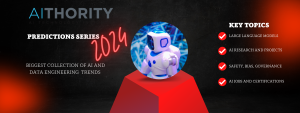Survey: AI Adoption Among Federal Agencies Is Up But Trust Continues to Be An Obstacle to Future Adoption and Use
Findings Reveal 80% of Public and Private sector Organizations are using AI and that Clear Acceptable Use, Privacy and Security Policies Need to be Set Early For AI Success
GovSummit23 – New research from Splunk Inc. the cybersecurity and observability leader, suggests that while the majority of public and private sector organizations are already using artificial intelligence (AI) in production, trust remains a major concern. Surprisingly, every respondent reported plans to implement AI – all were either using, testing, planning or investigating the use of AI technologies. However, despite this universal adoption, it’s clear that organizations need to set priorities and confront obstacles with a comprehensive planning framework to achieve positive business outcomes from AI.
Recommended AI News: Riding on the Generative AI Hype, CDP Needs a New Definition in 2024
 Organizations Need a Clear AI Strategy
Organizations Need a Clear AI Strategy
With nearly every other game-changing technology, the rapid rise of AI adoption has been sometimes fraught with missteps and roadblocks. According to the survey, organizations’ main concerns include building trust in AI-enabled systems and processes, ensuring data privacy and security, navigating system reliability issues and ensuring data quality.
Across both the public and private sectors, trust and reliability in AI-enabled systems – particularly around cybersecurity tools that leverage AI – continue to be the main concerns for decision-makers (48% public, 36% private), making it clear that early decisions about AI policies can make or break organizations’ long-term AI strategy.
Recommended AI News: Behavox Selected by Bny Mellon to Provide Next Generation AI Solution for Its Compliance Program
AI Adoption Among The Public and Private Sectors:
The survey paints a detailed picture of the similarities and differences between the public and private sector’s use of AI. Unlike previous emerging technologies, the rate of AI adoption among federal agencies (79%) is similar to the adoption across the public sector (83%). The survey found that this similarity has led to homogenous AI goals and challenges, including:
- Public Sector AI Priorities in 2024: In the public sector, half of the survey respondents pointed to continuous monitoring as a top tactic to defend AI-enabled systems against cybersecurity attacks, followed by threat intelligence solutions (45%) and developing an incident response plan (43%).
- Public and Private Sector Agree on Future AI Use: Respondents also noted innovation (31% public, 29% private), the use of AI technology to enhance goods or services (28% public, 31% private), and its role in improving citizen and customer experiences (30% public, 27% private) are the main drivers for their AI strategy.
- Cybersecurity is a Top AI Use Case: Most respondents (80%) reported their organizations were already addressing cybersecurity priorities with AI, including AI-enabled monitoring (34%), risk assessment (33%) and analysis of threat data (29%). With the use of tools that leverage large language models (LLMs) — like the Splunk AI assistant – organizations can optimize AI to drive faster detection, investigation and response to more effectively address their cybersecurity priorities.
- Regulations Continue to Be a Barrier: A commanding majority of survey respondents (78%) indicated that global ethical principles should guide the regulation of AI rather than it being the provenance of nation-states.
- Automation is the Key AI Driver: Forty-four percent of the private sector and 53% of the public sector are eager to use or are already using AI for automation to help increase productivity across their organizations.
Recommended AI News: Bybit Launches Bot Copy Trading, Revolutionizing Automated Crypto Trading
“For both the public and private sector, purpose-built AI solutions can help improve an organization’s resiliency,” said Bill Rowan, VP of Splunk Public Sector, Splunk. “However, the push and pull between eagerness to innovate and hesitancy to venture blindly into the unknown will continue to hinder AI innovation until we have a clear body of general principles and rules for AI technology use and adoption.”
[To share your insights with us, please write to sghosh@martechseries.com]

Comments are closed.